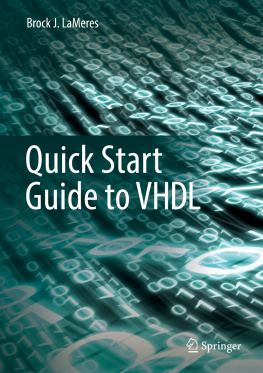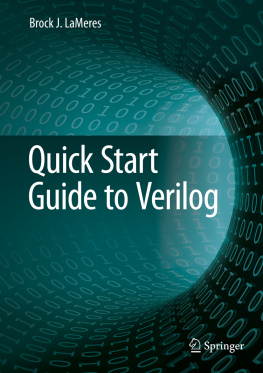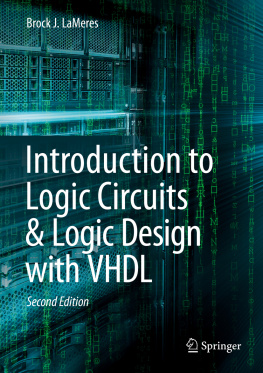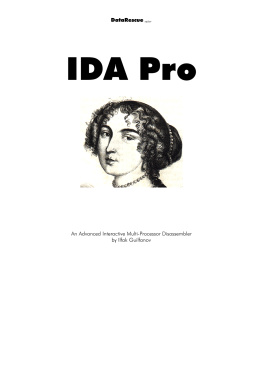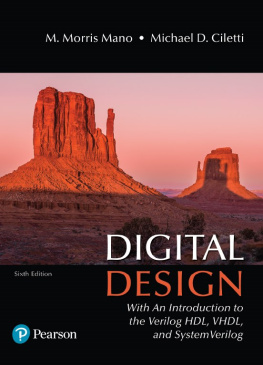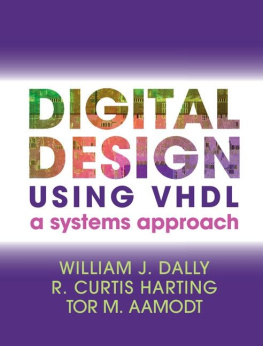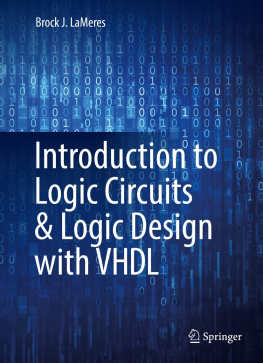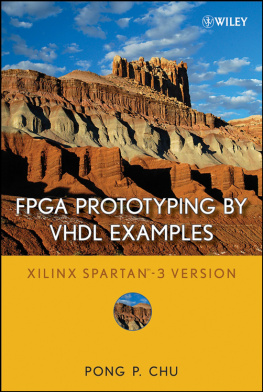Brock J. LaMeres - Quick Start Guide to VHDL
Here you can read online Brock J. LaMeres - Quick Start Guide to VHDL full text of the book (entire story) in english for free. Download pdf and epub, get meaning, cover and reviews about this ebook. year: 0, publisher: Springer International Publishing, genre: Computer. Description of the work, (preface) as well as reviews are available. Best literature library LitArk.com created for fans of good reading and offers a wide selection of genres:
Romance novel
Science fiction
Adventure
Detective
Science
History
Home and family
Prose
Art
Politics
Computer
Non-fiction
Religion
Business
Children
Humor
Choose a favorite category and find really read worthwhile books. Enjoy immersion in the world of imagination, feel the emotions of the characters or learn something new for yourself, make an fascinating discovery.
- Book:Quick Start Guide to VHDL
- Author:
- Publisher:Springer International Publishing
- Genre:
- Year:0
- Rating:5 / 5
- Favourites:Add to favourites
- Your mark:
- 100
- 1
- 2
- 3
- 4
- 5
Quick Start Guide to VHDL: summary, description and annotation
We offer to read an annotation, description, summary or preface (depends on what the author of the book "Quick Start Guide to VHDL" wrote himself). If you haven't found the necessary information about the book — write in the comments, we will try to find it.
Quick Start Guide to VHDL — read online for free the complete book (whole text) full work
Below is the text of the book, divided by pages. System saving the place of the last page read, allows you to conveniently read the book "Quick Start Guide to VHDL" online for free, without having to search again every time where you left off. Put a bookmark, and you can go to the page where you finished reading at any time.
Font size:
Interval:
Bookmark:
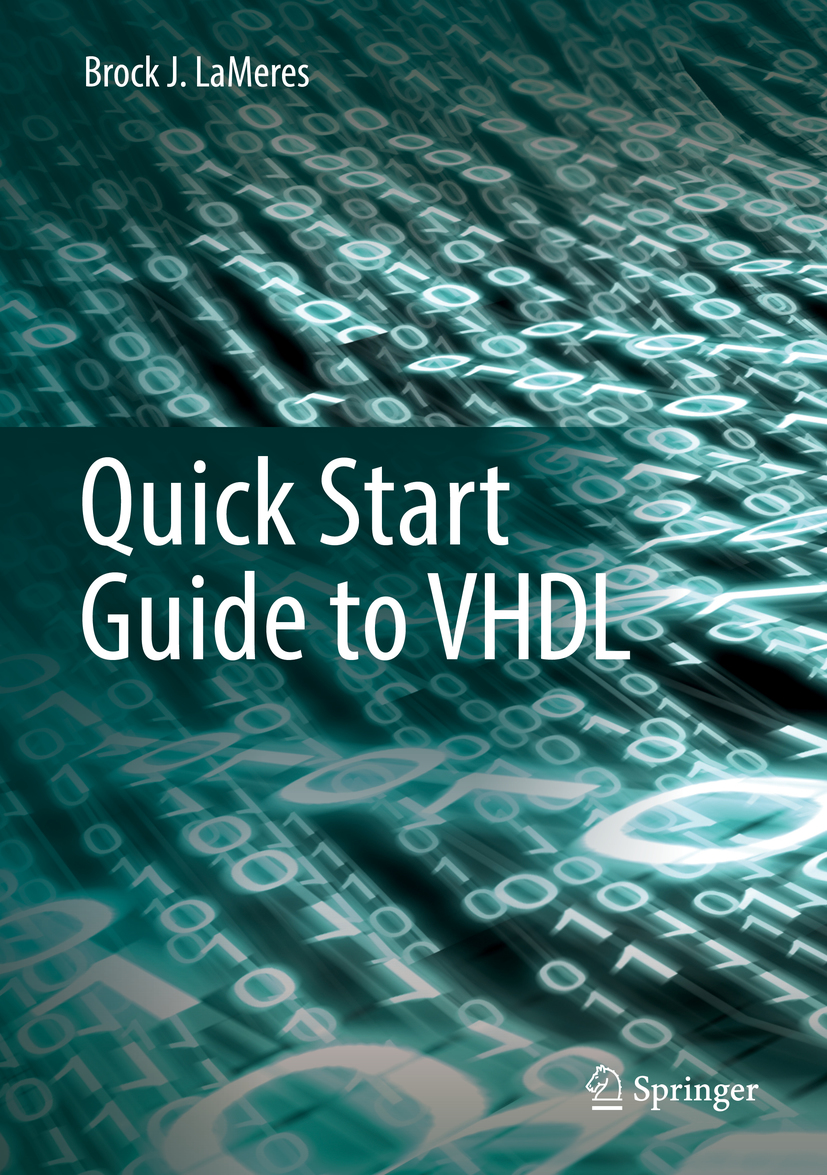

Cover illustration: Carloscastilla Dreamstime.com - Binary Code Photo
This Springer imprint is published by the registered company Springer Nature Switzerland AG
The registered company address is: Gewerbestrasse 11, 6330 Cham, Switzerland
The classical digital design approach (i.e., manual synthesis and minimization of logic) quickly becomes impractical as systems become more complex. This is the motivation for the modern digital design flow, which uses hardware description languages (HDL) and computer-aided synthesis/minimization to create the final circuitry. The purpose of this book is to provide a quick start guide to the VHDL language, which is one of the two most common languages used to describe logic in the modern digital design flow. This book is intended for anyone that has already learned the classical digital design approach and is ready to begin learning HDL-based design. This book is also suitable for practicing engineers that already know VHDL and need quick reference for syntax and examples of common circuits. This book assumes that the reader already understands digital logic (i.e., binary numbers, combinational and sequential logic design, finite state machines, memory, and binary arithmetic basics).
Since this book is designed to accommodate a designer that is new to VHDL, the language is presented in a manner that builds foundational knowledge first before moving into more complex topics. As such, Chaps. as they use the types std_logic and std_logic_vector . For a VHDL novice, understanding the history and fundamentals of the VHDL base release will help form a comprehensive understanding of the language; thus it is recommended that the early chapters are covered in the sequence they are written.
For Alexis. The world is a better place because you are in it.
The purpose of a hardware description languages is to describe digital circuitry using a text-based language. HDLs provide a means to describe large digital systems without the need for schematics, which can become impractical in very large designs. HDLs have evolved to support logic simulation at different levels of abstraction. This provides designers the ability to begin designing and verifying functionality of large systems at a high level of abstraction and postpone the details of the circuit implementation until later in the design cycle. This enables a top-down design approach that is scalable across different logic families. HDLs have also evolved to support automated synthesis, which allows the CAD tools to take a functional description of a system (e.g., a truth table) and automatically create the gate-level circuitry to be implemented in real hardware. This allows designers to focus their attention on designing the behavior of a system and not spend as much time performing the formal logic synthesis steps as in the classical digital design approach. The goal of this chapter is to provide the background and context of the modern digital design flow using an HDL-based approach.
There are two dominant hardware description languages in use today. They are VHDL and Verilog. VHDL stands for very high speed integrated circuithardwaredescriptionlanguage. Verilog is not an acronym but rather a trade name. The use of these two HDLs is split nearly equally within the digital design industry. Once one language is learned, it is simple to learn the other language, so the choice of the HDL to learn first is somewhat arbitrary. In this text, we will use VHDL to learn the concepts of an HDL. VHDL is stricter in its syntax and typecasting than Verilog, so it is a good platform for beginners as it provides more of a scaffold for the description of circuits. This helps avoid some of the common pitfalls that beginners typically encounter. The goal of this chapter is to provide the background and context of the modern digital design flow using an HDL-based approach.
- 1.1
Describe the role of hardware description languages in modern digital design.
- 1.2
Describe the fundamentals of design abstraction in modern digital design.
- 1.3
Describe the modern digital design flow based on hardware description languages.
The invention of the integrated circuit is most commonly credited to two individuals who filed patents on different variations of the same basic concept within 6 months of each other in 1959. Jack Kilby filed the first patent on the integrated circuit in February of 1959 titled Miniaturized Electronic Circuits while working for Texas Instruments. Robert Noyce was the second to file a patent on the integrated circuit in July of 1959 titled Semiconductor Device and Lead Structure while at a company he cofounded called Fairchild Semiconductor. Kilby went on to win the Nobel Prize in Physics in 2000 for his invention, while Noyce went on to cofound Intel Corporation in 1968 with Gordon Moore. In 1971, Intel introduced the first single-chip microprocessor using integrated circuit technology, the
Font size:
Interval:
Bookmark:
Similar books «Quick Start Guide to VHDL»
Look at similar books to Quick Start Guide to VHDL. We have selected literature similar in name and meaning in the hope of providing readers with more options to find new, interesting, not yet read works.
Discussion, reviews of the book Quick Start Guide to VHDL and just readers' own opinions. Leave your comments, write what you think about the work, its meaning or the main characters. Specify what exactly you liked and what you didn't like, and why you think so.

